Summary
California’s higher education system is a critical driver of the state’s economic progress. As the state’s economy continues to change, will its workforce be ready for the jobs of tomorrow?
This report updates and extends projections of California’s workforce skills through 2030, focusing on the supply and demand for workers with a bachelor’s degree. We find that the state will fall about 1.1 million college graduates short of economic demand if current trends persist-a problem we call the workforce skills gap. Even the arrival of highly educated workers from elsewhere is unlikely to be large enough to fill this gap.
Today’s college graduates have better economic outcomes than those who do not hold a bachelor’s degree. Over time, college graduates have seen lower rates of unemployment and higher wages than other workers-even through the Great Recession’suggesting that college degrees have become increasingly valuable in California’s labor market.
The future workforce skills gap looms large. But California and its higher education institutions can take several practical steps to close it. The core of a new plan for higher education should include increasing access to the state’s four-year institutions, improving college completion rates, expanding transfer pathways from community colleges, and being smart about aid programs.
Introduction
PPIC has produced a number of reports on the workforce skills gap (Johnson 2009; Reed 2008; Johnson and Reed 2007). Since then, the state has endured the worst recession since the Great Depression; the Great Recession generated both a substantial decline in employment and a change in the composition of jobs and occupations in California. The recession also triggered dramatic decreases in funding for the state’s public colleges and universities, leading to restrictions on enrollment and increases in student debt (Johnson et al. 2013).
New projections are needed to estimate how the recession and subsequent recovery have changed the trajectory of both the California economy and the educational attainment of Californians. In addition, extending the projections to 2030 incorporates the retirement of the numerous and highly educated members of the baby boom generation-a major population shift that will have significant effects on California’s labor force. Finally, with these new numbers in hand-and with increased attention to higher education issues in Sacramento-the time is right to consider a new plan for the future of higher education in the state.
The Workforce Skills Gap in 2030
If current trends in the labor market persist, by 2030 California will have a shortage of 1.1 million workers holding a bachelor’s degree.1 This projection is based on recent economic trends and on forecasts that show a continued increase in the demand for highly educated workers, a demand that is not going to be met by expected increases in the supply of college graduates. We project that 38 percent of all jobs will depend on workers with at least a bachelor’s degree, but only about 33 percent of workers will have one in 2030 (Figure 1).2
Figure 1. Demand for highly educated workers will exceed supply in 2030
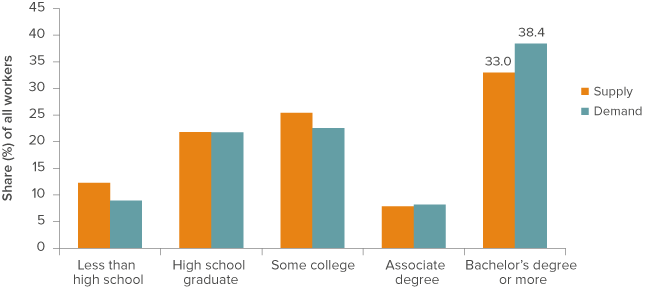
SOURCE: Authors’ projections.
NOTE: See the technical appendices for data and methods.
We do project small improvements in Californians’ educational attainment levels, with declines in the share of high school dropouts and increases in the share of college graduates. By 2030, the share of workers with a bachelor’s degree will be 33 percent, an increase from 32 percent in 2013.3 This relatively slow increase in the number of highly educated workers stems from the retirement of the highly educated baby boom generation. Replacing this large and well-educated group will be a tremendous challenge, as we discuss below.
The arrival of new highly educated workers from elsewhere will not close the gap. To be sure, the share of international immigrants arriving with college degrees-especially in the technology sector-has played an important role in increasing the share of young workers who hold at least a bachelor’s degree. But much larger increases in international migration will be necessary for the supply of highly educated workers to meet the demand, and it is unlikely that further increases in international migration will be sufficient.4
It is important to note that our projections of the distribution of workers by educational attainment are based on a continuation of recent trends, and our outcomes are sensitive to the period we use to generate these trends. Depending on the period, our projections can vary by several hundred thousand workers. But no matter what period we use to develop our projections, we find a large deficit in the supply of workers holding at least a bachelor’s degree, ranging from about 1 million to 1.4 million (see Figure 4 in Technical Appendix C).
The Economy, Jobs, and a College Education
Projecting California’s future economy, a difficult task under any circumstance, has been made more challenging by the Great Recession (December 2008-January 2009). All sectors of the economy were affected, and the state lost nearly 8 percent of its jobs. These changes led economists to lower their long-term forecasts of job growth in the state.5
Some jobs lost during a recession are recovered as the economy improves, but other jobs do not return at all. In addition, different, new jobs are created during recoveries. As we shall see, the projected increase in demand for highly educated workers is not driven by a broad economic shift toward particular occupations that require greater levels of education. Instead, we expect to see growth in the demand for highly educated workers within broad occupational categories.
The Great Recession and the value of a college degree
The Great Recession led to increases in unemployment rates and declines in labor force participation rates across every segment of the state’s population. But-as with most recessions-it hit less educated workers especially hard.
Even now, after several years of job growth, unemployment rates remain far higher than they were before the recession (Figure 2). The greatest increases in unemployment have been among workers with only a high school diploma or with some college education but no bachelor’s degree.6 Even for workers with a bachelor’s degree, unemployment rates were higher in 2014 than in the pre-recession year of 2007. But they remain far lower than the rates for other, less educated workers-evidence of a continuing strong demand for highly educated workers.
Figure 2. Unemployment rates are lower for more highly educated workers

SOURCE: Authors’ calculations based on March 2007 and 2014 Current Population Survey data.
NOTE: These numbers include all members of the labor force ages 16 and older.
Workers with more education not only are more likely to be employed but are also, on average, gaining ground in terms of pay. Economic returns to a college degree have steadily increased over the last several years (Figure 3). In 2005, college-degree holders earned slightly above 60 percent more than similar workers who held only a high school diploma; by 2013, they earned about 70 percent more. These wage gains suggest that college degrees are increasingly valuable in the labor market.
Figure 3. Wage premiums for highly educated workers are increasing
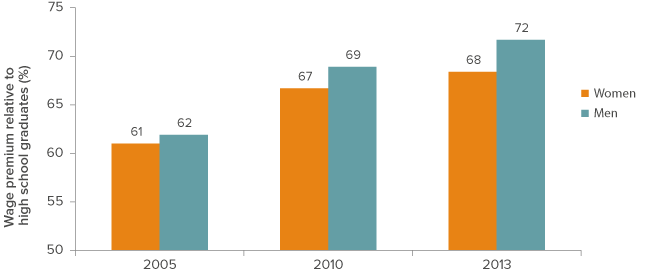
SOURCE: Authors’ calculations based on American Community Survey data for 2005, 2010, and 2013.
NOTE: The chart shows the difference in wages for workers with at least a bachelor’s degree versus those with a high school diploma. These estimates are regression-adjusted for age, gender, and ethnicity.
Of course, the labor market does not value all college degrees equally. For degrees in highly lucrative fields, such as engineering and computer science, the lifetime wage premium-that is, the expected present value of the gain in wages by completing college, even after accounting for college costs-can total more than $1 million; but even for degrees with the lowest economic returns, the lifetime wage premium totals more than $200,000 (Johnson et al. 2013).7
Future jobs
To assess California’s future job market, we rely on long-term occupational projections from the state’s Employment Development Department (EDD).8 Here, we are concerned not just with changes in the state’s overall occupational mix but also with changes in skills requirements within occupational categories. Understanding these changes helps to provide a clearer picture of where the growth in demand for college degrees is likely to occur. To do so, we look at both broad occupational categories, such as business operations, and jobs within those categories, such as marketing specialists.
The projections suggest that the mix of occupational categories in California’s labor market is not going to change drastically over the next decade or so. The fastest-growing occupational categories will include both high-skilled and low-skilled categories.9 For example, of the three fastest-growing categories, only one (computer and mathematical science) has a high share of college graduates.10 Among the ten fastest-growing categories, five require high levels of educational attainment, and five do not. The strongest job growth will occur at either end of the education spectrum, with the largest increases in occupational categories that require only a high school diploma on the one end and those that require at least a bachelor’s degree at the other end. In other words, the bifurcation of California’s occupational mix, an important component of wage inequality, is expected to continue.11
Because the demand for highly educated workers within occupational categories has been growing over the past decade, even though the mix of these categories is not shifting much, we expect the economy to require a higher share of educated workers by 2030. In most occupational categories, the share of workers holding at least a bachelor’s degree is projected to increase by 2030 (Figure 4).
Figure 4. Demand for college educated workers will increase in most occupational categories by 2030
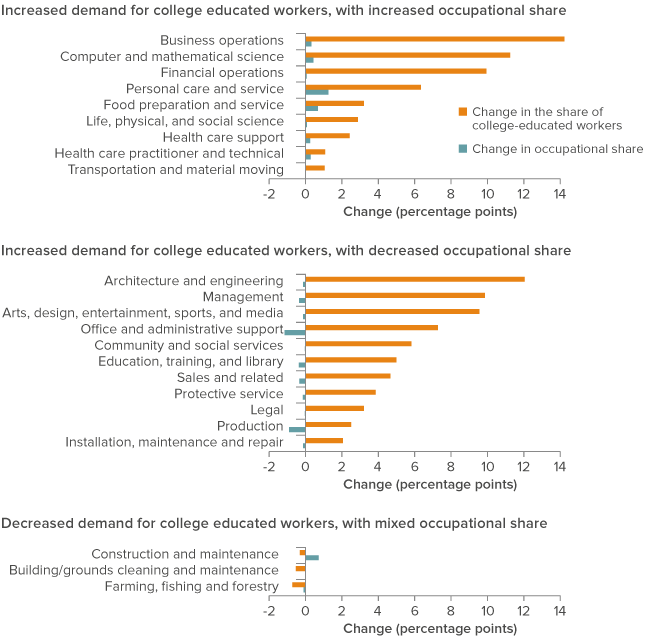
SOURCE: Authors’ estimates and projections based on EDD and American Community Survey data for 2013-30.
NOTE: See the technical appendices for methods and detailed estimates underlying this figure.
These shares are projected to increase in most occupational categories, from those regarded as high skill (such as management) to those regarded as low skill (food preparation). Some of this increase will be caused by a shift toward specific occupations within broader occupational categories. But the larger shift is likely to be an increase in educational attainment within specific occupations themselves.
Business operations is a case in point. In 2000, about half of the workers in the business operations occupational category held a bachelor’s degree; by 2013, this share had increased to 60 percent. If these trends continue, 74 percent will have a bachelor’s degree in 2030-a 14 percentage point increase over 17 years. But as an overall occupational category, business operations will make up a similar share of the economy as it does today-3.0 percent in 2030, compared with 2.7 percent in 2013.
The increase in educational attainment within this occupational category is occurring because its fastest-growing specific occupations include some with high levels of education-for example, among market research analysts and marketing specialists, 75 percent have at least a bachelor’s degree. In addition, some specific occupations have seen a large increase in the share of workers with college degrees-for example, the share of fundraisers with a bachelor’s degree increased from 44 percent in 2000 to 84 percent in 2013.
Overall, there are no indications that the rocky economic landscape of the recent recession has shifted the trend in demand for highly educated workers. In the past, a strong demand for highly educated workers occurred as the economy shifted toward occupational categories and industries that demanded these workers. But in the 1990s and-based on our current analysis-through the 2000s, the strong demand for highly educated workers has reflected growth in education levels within industries and occupations (Reed 2008).
Do these projections indicate a real demand, or are they simply evidence of a trend toward overeducating the workforce? One way to distinguish between these two possibilities is to examine the wage premium paid to college workers-that is, the extra wages employers are willing to pay college workers compared with less educated workers-in the same occupational category. Positive and increasing wage premiums for college-educated workers reflects the economic demand for skills. As Figure 3 showed, the college wage premium is large and increasing economy-wide; moreover, we find that within occupational categories, the same is generally true. College-educated workers enjoy positive and significant wage premiums within almost every occupational category (see Table 5 in Technical Appendix C). These findings indicate that the strong demand for highly educated workers is likely to continue because employers and the economy require the skills associated with more highly educated workers.
Population Change and the Workforce Skills Gap
Over the next 15 years, California’s population will change in ways that will significantly affect its workforce. The state’s recent population-growth rates have been relatively low, averaging only about 1 percent per year, and these slow growth rates are likely to continue.12 Overall, we project that the labor force will only grow about 9 percent between 2013 and 2030. This is partly because of the tremendous growth we expect to see in the senior population-the group of Californians age 60 and older will grow 41 percent, while the group ages 20 to 59 will grow only 5 percent.
The share of adults in the workforce with a bachelor’s degree or more will increase only slightly-about 1 percent-by 2030. To a great extent, this slow growth stems from the retirement of the numerous and very highly educated members of the baby boom generation. Today, the best-educated age group in California consists of adults ages 60 to 64 (Figure 5). By 2030, these adults will be retired.
In the past, retirees tended to be less educated and relatively few in number-and they were replaced by younger, more-numerous, and more-educated young adults. Going forward, this will no longer be the case. Indeed, the retirement of the baby boomers represents the first time in California’s history that such a large and well-educated generation is exiting the labor force. This loss helps to explain the size of the skills gap we see in 2030.
Figure 5. Older Californians are more likely to be college graduates
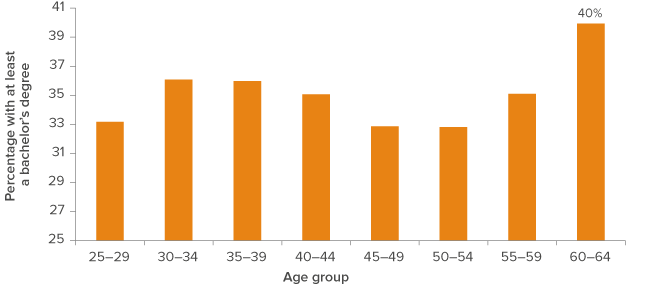
SOURCE: American Community Survey 2011, 2012, and 2013 (combined).
NOTE: See the technical appendices for data and methods.
California is unlikely to attract enough highly educated migrants from elsewhere to close the skills gap. For a long time, the state has relied on migrants to supply employers with the college graduates they need. Before 2010, more of California’s college graduates, by percentage, were born elsewhere in the United States (Figure 6). Since 1980, however, the share of college graduates from other countries has increased quickly, a reflection of the globalization of the state’s economy-and we expect this to continue. Were it not for these increases, the size of the skills gap would be even larger.
California residents are making slight improvements in educational attainment. Indeed, in 2010, for the first time in the state’s history, more of California’s college graduates were born in the state (37%) than in other states (33%) or internationally (30%). Going forward, California’s best approach to closing its skills gap will be to concentrate on improving the educational attainment of its residents.
Figure 6. California’s college graduates are increasingly likely to be born in the state
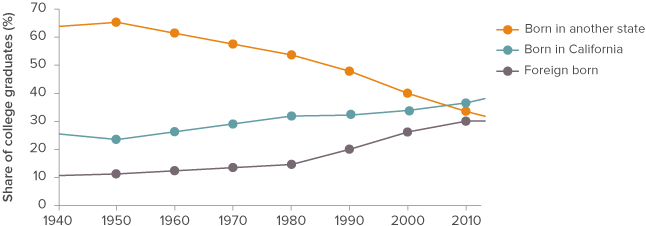
SOURCE: Authors’ calculations based on decennial censuses and American Community Survey data.
NOTE: “Born in another state” includes U.S. territories and those born of American parents outside the United States. Last year of data is 2013.
Policy implications
Improving college enrollment and completion has multiple, wide-ranging benefits. Individuals benefit from higher wages and less unemployment-in fact, wage premiums for college graduates in California are at all-time highs, and unemployment rates are far lower than for less educated workers. The state benefits from increased tax revenues and less demand for social services (Stiles, Hout, and Brady 2012). Of course, improving educational attainment has other societal benefits as well, including the creation of a more knowledgeable and engaged citizenry.
Our projections indicate that the demand for college graduates will outpace the supply by 2030, if current trends continue. The gap is substantial, with the economy needing 1.1 million more college graduates than the state will produce. But if the state, its educational institutions, and its people are able to improve educational outcomes, California and its residents will experience a much more successful future, with higher incomes, greater tax revenues, and lower use of social services.13
Closing the workforce skills gap will require improvements in several important areas. Here, we touch on a few key strategies for the state and its higher education institutions to pursue:
Increase access. Students are much more likely to earn a bachelor’s degree if they first enroll in a four-year college, as opposed to a community college, even accounting for differences in academic preparation (Long and Kurlaender, Grosz 2008; Johnson 2015). Therefore, one way to increase the number of college graduates in California is to increase the share of high school graduates eligible for the University of California (UC) and the California State University (CSU). Doing so would also improve access for students from low-income and underrepresented groups.
Improve completion and time to degree. At CSU, only 19 percent of students earn a bachelor’s degree within four years, and just over half (54%) do so in six years; at UC, about 60 percent graduate in four years and 80 percent do so in six years.14 Both systems have used multiple strategies to increase these rates, including mandatory advising for at-risk students, eliminating bottlenecks by redesigning courses with high failure rates, increasing capacity for high-demand required courses, and using data to develop an early-warning system. These and other efforts should continue to be assessed to identify which are most effective. One new approach would be to provide fiscal incentives to colleges for increasing the share of students taking a full load (15 units). Much could be learned from the private, nonprofit colleges in the state, which have high four-year completion rates.
Expand transfer degrees. Because of the state’s heavy reliance on community colleges, improving transfer pathways from those colleges to four-year institutions is essential. The vast majority of community college students do not earn a degree or certificate, leading to the large pool of California adults who have some college education but no degree. For new and current students, programs such as the associate degree for transfer should be expanded. These degrees guarantee access to CSU for community college students who fit the required criteria. However, these degrees still depend on individual agreements between specific campuses and specific majors. Expanding the program to include more majors and more campuses (including UC) should lead to increases in the number of students who transfer from the community colleges and ultimately earn bachelor’s degrees.
Be smart about aid. Compared with other states, California has done a fairly good job at keeping college costs down, but more could be done. Grant and aid programs, including Cal Grants and institutional grants and scholarships, mean that most low-income, and even some middle-income, students do not have to pay tuition at the state’s public colleges and universities. But other education costs are not well covered, and student debt has been rising-raising questions about whether Cal Grants should cover more than just tuition at public colleges. The state should also consider whether to increase the size of Cal Grants to students at private colleges with good graduation track records and whether to further decrease Cal Grants to institutions with low graduation rates and high loan-default rates. Improved evaluation of the effects of grant aid on student outcomes would help answer these questions.
These strategies should form the core of a new state plan for higher education-and they illustrate the need to coordinate across institutions and issues. Any new plan should include ambitious goals, to ensure that enough high school graduates are ready for college, enough slots are available for new college students, more community college students are able transfer to four-year institutions, and more students complete college in four years. Most important, California and its higher education institutions must strengthen access to college for low-income and underrepresented students.
It is a tall order-but not impossible. PPIC’s Statewide Surveys show that Californians place a very high priority on higher education and are eager to find ways for students and the state to succeed.15 And if California is able to pull it off, the economic and societal benefits will be significant.
